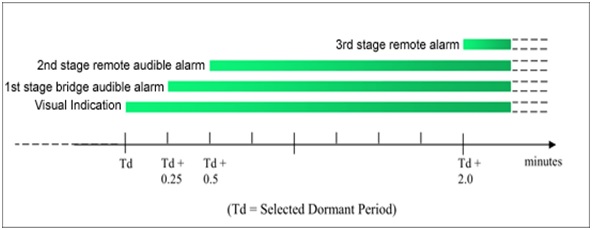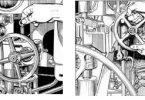Is it necessary to connect the BNWAS to the VDR?
According to the Code on Alerts and Indicators, Resolution A.1021(26), implemented on 18 January 2010, the BNWAS first-stage audible alarm and the malfunction of, or power supply failure to, the BNWAS are classified as a mandatory alarm. The BNWAS should be connected to the VDR on ships whose keel is laid on or after 18 January 2010.
What is IMO performance standard requirements for BNWAS?
IMO performance standard for BNWAS are as follows:
Operational modes
The BNWAS shall incorporate the following operational modes:
- Automatic (Automatically brought into operation whenever the ship’s heading or track control system is activated and inhibited when this system is not activated)
- Manual ON (In operation constantly)
- Manual OFF (Does not operate under any circumstances)
- Operational sequence of indications and alarms
Dormant period
Once operational, the alarm system shall remain dormant for a period of between 3 and 12 min (Td). At the end of this dormant period, the alarm system shall initiate a visual indication on the bridge.

Figure: Alarm Sequence Without Acknowledgements.
First stage alarm
If not reset, the BNWAS shall additionally sound a first stage audible alarm on the bridge 15 s after the visual indication is initiated.
Second stage alarm
If not reset, the BNWAS shall additionally sound a second stage remote audible alarm in the back-up officer’s and/or Master’s location 15 s after the first stage audible alarm is initiated.
Third stage alarm
If not reset, the BNWAS shall additionally sound a third stage remote audible alarm at the locations of further crew members capable of taking corrective actions 90 s after the second stage remote audible alarm is initiated.
Alarm alternatives
In vessels other than passenger vessels, the second or third stage remote audible alarms may sound in all the above locations at the same time. If the second stage audible alarm is sounded in this way, the third stage alarm may be omitted.
In larger vessels, the delay between the second and third stage alarms may be set to a longer value on installation, up to a maximum of 3 min, to allow sufficient time for the back-up officer and/or Master to reach the bridge.
Facilities shall be provided to inhibit the third stage alarm and to increase the delay between the second and third stage alarms to 3 min.
Reset function
The reset function shall, by a single operator action, cancel the visual indication and all audible alarms and initiate a further dormant period. If the reset function is activated before the end of the dormant period, the period shall be re-initiated to run for its full duration from the time of the reset.
Initiation of reset function
To initiate the reset function, an input representing a single operator action by the 00W is required. This input may be generated by reset devices forming an integral part of the BNWAS or by external inputs from other equipment capable of registering physical activity and mental alertness of the 00W.
Continuous activation
A continuous activation of any reset device shall not prolong the dormant period or cause a suppression of the sequence of indications and alarms.
Emergency call facility
Means may be provided on the bridge to immediately activate the second, and subsequently third, stage remote audible alarms by means of an “Emergency Call” push button or similar.
Facilities shall be provided for an “Emergency Call” system.
Accuracy
The alarm system shall be capable of achieving the timings stated in above paragraph with an accuracy of 5% or 5 s, whichever is less, under all environmental conditions.
Security
The means of selecting the Operational Mode and the duration of the Dormant Period (Td) shall be security protected so that access to these controls should be restricted to the Master only.
Malfunctions, alarms and indications
If a malfunction of, or power supply failure to, the BNWAS is detected, this shall be indicated. Means shall be provided to allow the repeat of this indication on a central alarm panel if fitted.


